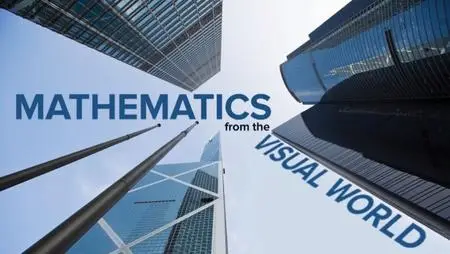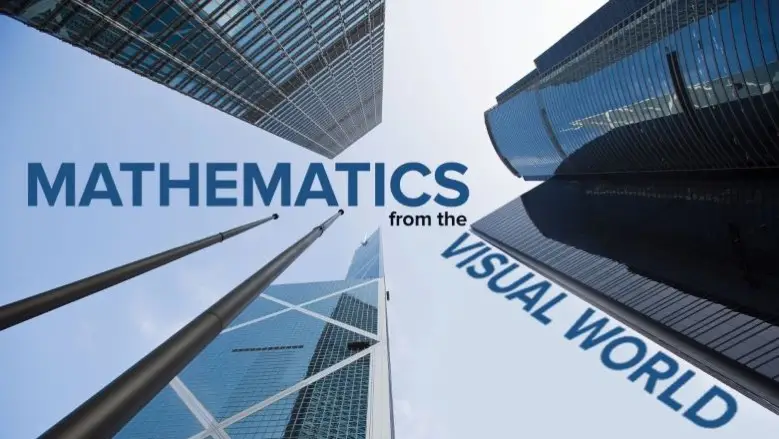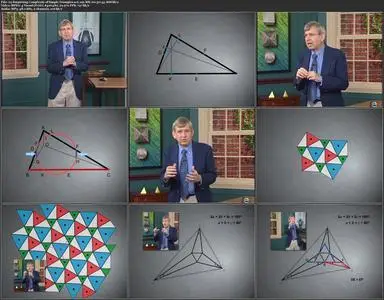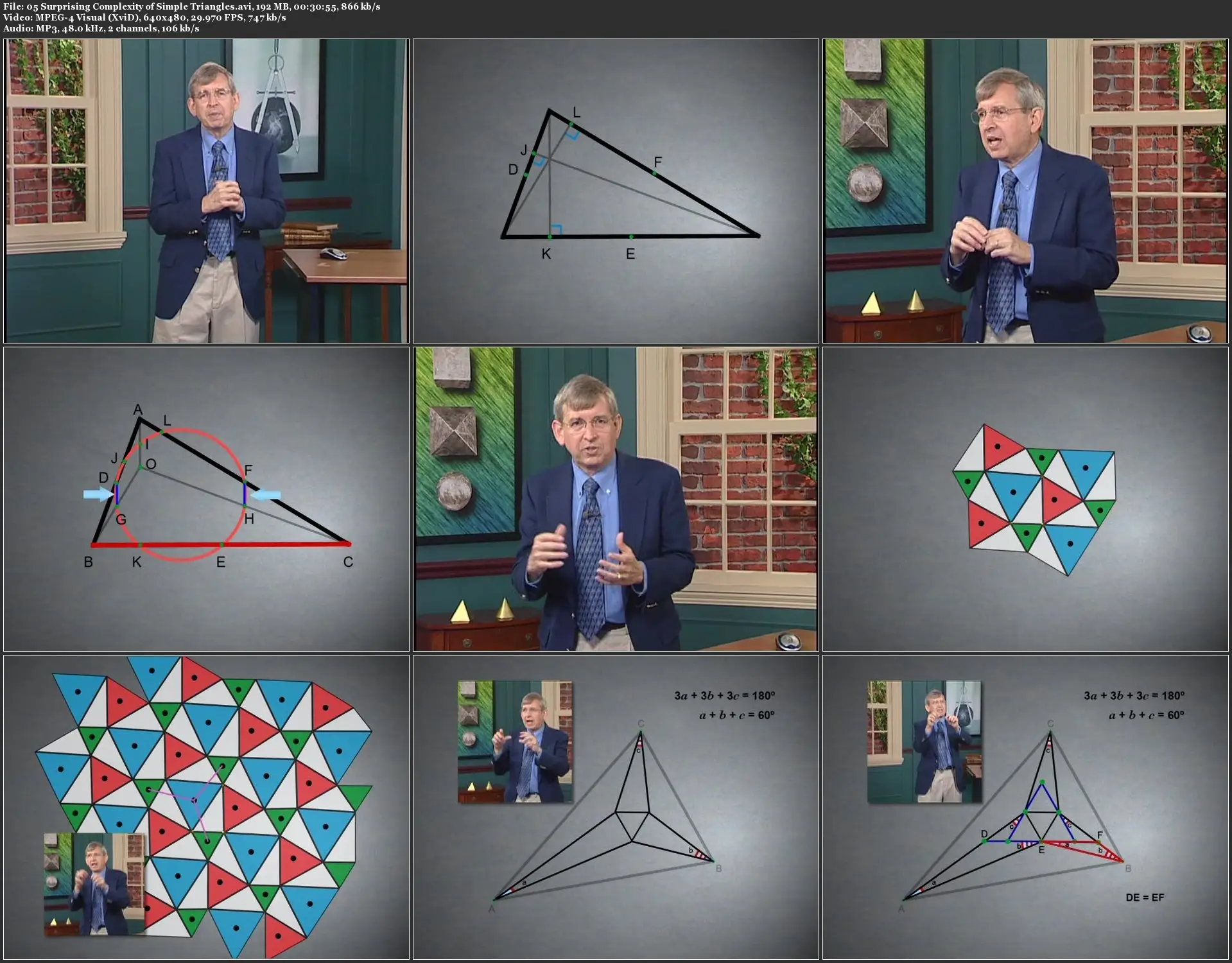TTC Video - Mathematics from the Visual World
.AVI, XviD, 640x480, 30 fps | English, MP3, 2 Ch | 12h 25m | 4.52 GB
Lecturer: Michael Starbird, Ph.D. Professor, The University of Texas at Austin | Course No. 1447
.AVI, XviD, 640x480, 30 fps | English, MP3, 2 Ch | 12h 25m | 4.52 GB
Lecturer: Michael Starbird, Ph.D. Professor, The University of Texas at Austin | Course No. 1447
Geometry has long been recognized not only as a fascinating skill, but as a gateway to the highest realms of human thought. Mathematics from the Visual World, taught by distinguished Professor Michael Starbird, introduces you to the terms, concepts, and astonishing power of geometry, including topology, conic sections, non-Euclidian geometry, congruence, and much more.
In 24 richly illustrated lectures, you discover the important role this profound mathematical field plays in everything from algebra and calculus to cosmology and chemistry to art and architecture. This delightful, invigorating, and enlightening journey will allow you to master one of the most glorious inventions of the human mind.
Plato's Academy in Athens was the think tank of the ancient world and bore this motto over its door: "Let no one ignorant of geometry enter here." Ever since, geometry has been recognized as not only a useful and fascinating skill, but also as a gateway to the highest realms of human thought. Seemingly simple geometric ideas such as the Pythagorean theorem turn out to have profound implications in unexpected places, including our modern conception of space and time.
Mathematics from the Visual World, taught by veteran Teaching Company Professor Michael Starbird of The University of Texas at Austin, takes Plato's dictum to heart and introduces you to the terms, concepts, and astonishing power of geometry.
In 24 richly illustrated lectures, you learn that geometry is everywhere. It is the key to scientific disciplines from cosmology to chemistry. It is central to art and architecture. It provides deep insights into algebra, calculus, and other mathematical fields. And it is stunning to contemplate in its beauty.
Consider these intriguing applications of geometry:
Intellect and Eye
From the simplicity of the golden rectangle to the infinitely complex realm of fractals, no other area of mathematics is so richly endowed with interesting examples as geometry, which appeals to both the intellect and the eye. All of geometry's many applications make use of the bedrock concepts of axioms, theorems, and proofs. In Mathematics from the Visual World, you discover that these traditional techniques are not ends in themselves but tools for gaining new insights such as these:
On a more everyday level, you may be interested to know that the age-old problem of how to cut a square cake so that each piece has the same quantity of icing is easily solved.
Famous Problems
Geometry is also richly endowed with famous problems, some with life-or-death implications. Take the Delian Problem: Legend has it that in ancient Athens the citizens consulted the oracle at Delos for advice on how to stop a deadly plague. The oracle replied that the plague would end if the Athenians doubled the size of their cube-shaped altar to the god Apollo. So the Athenians doubled each side. But the plague continued unabated. The oracle had meant that they should double the altar's volume, not its linear dimensions.
Doubling the cube in this way is a classic problem from antiquity, which Professor Starbird proves is impossible to solve with the traditional tools of a straightedge and compass. However, in the 17th century Isaac Newton showed that the construction can be done if one is allowed to make two marks on the straightedge. Dr. Starbird explains how this clever trick works.
Here are some other famous problems that you investigate in Mathematics from the Visual World:
A Delightful, Enlightening, and Invigorating Journey
A specialist in geometry and topology, Dr. Starbird is not only Professor of Mathematics at The University of Texas at Austin but also University Distinguished Teaching Professor. He has won an impressive array of teaching awards, including most of the major teaching awards at UT, a prestigious statewide teaching award, and the national teaching award from the Mathematical Association of America.
Professor Starbird believes that there is no excuse for a dull course on mathematics, a philosophy he pursues throughout Mathematics from the Visual World. In Lecture 1 he says, "To me, the satisfying aspect of a great proof occurs when the proof reveals some underlying, often surprising connection or relationship from which we see some truth that we previously could not fathom. When we see such a proof, we might say, 'Aha, that's why it's true.'" Although they don't always come easily, you have many such "aha" moments in this course.
An old story recounts that King Ptolemy of Egypt asked Euclid, the father of geometry, whether there was a simpler way to understand the axioms, theorems, and proofs of the subject. Euclid's famous answer was, "There is no royal road to geometry." However, now there is Professor Starbird's road, which is a delightful, enlightening, and invigorating journey through one of the most glorious inventions of the human mind.
Mathematics from the Visual World, taught by veteran Teaching Company Professor Michael Starbird of The University of Texas at Austin, takes Plato's dictum to heart and introduces you to the terms, concepts, and astonishing power of geometry.
In 24 richly illustrated lectures, you learn that geometry is everywhere. It is the key to scientific disciplines from cosmology to chemistry. It is central to art and architecture. It provides deep insights into algebra, calculus, and other mathematical fields. And it is stunning to contemplate in its beauty.
Consider these intriguing applications of geometry:
- Conic sections: Euclid and other ancient mathematicians investigated conic sections—the shapes produced by the intersection of a plane and a cone. Two thousand years later, Galileo, Kepler, and Newton discovered that these shapes describe the paths followed by free-falling objects in a gravitational field.
- Non-Euclidean geometry: Euclidean geometry is simple and intuitive, and it appears to govern the world around us. But a nagging problem with Euclid's concept of parallel lines led to the discovery of new geometries in the 1800s. These non-Euclidean geometries accurately reflect phenomena in physics and other disciplines.
- Topology: Under what conditions can a coffee cup and a doughnut be considered the same? When they are analyzed in topology—the branch of mathematics that deals with shapes that retain their identity after twisting and stretching. Topology captures fundamental geometric properties of objects, giving us a new perspective on reality.
Intellect and Eye
From the simplicity of the golden rectangle to the infinitely complex realm of fractals, no other area of mathematics is so richly endowed with interesting examples as geometry, which appeals to both the intellect and the eye. All of geometry's many applications make use of the bedrock concepts of axioms, theorems, and proofs. In Mathematics from the Visual World, you discover that these traditional techniques are not ends in themselves but tools for gaining new insights such as these:
- In exploring the surprisingly diverse ways of defining the center of a triangle, you learn that one type of center, and the associated circle that inscribes the triangle with that center, led to a breakthrough in skin-grafting techniques for surgeons.
- The unusual shape of art galleries, with many nooks and crannies, raises the question of how many security cameras suffice to protect the room. You learn creative strategies for attacking this problem and reaching a solution.
- The shape of the universe itself is subject to simple geometric analysis. The observations themselves may be tricky, but Dr. Starbird shows that distinguishing among three possible geometries is relatively straightforward once we have the data.
On a more everyday level, you may be interested to know that the age-old problem of how to cut a square cake so that each piece has the same quantity of icing is easily solved.
Famous Problems
Geometry is also richly endowed with famous problems, some with life-or-death implications. Take the Delian Problem: Legend has it that in ancient Athens the citizens consulted the oracle at Delos for advice on how to stop a deadly plague. The oracle replied that the plague would end if the Athenians doubled the size of their cube-shaped altar to the god Apollo. So the Athenians doubled each side. But the plague continued unabated. The oracle had meant that they should double the altar's volume, not its linear dimensions.
Doubling the cube in this way is a classic problem from antiquity, which Professor Starbird proves is impossible to solve with the traditional tools of a straightedge and compass. However, in the 17th century Isaac Newton showed that the construction can be done if one is allowed to make two marks on the straightedge. Dr. Starbird explains how this clever trick works.
Here are some other famous problems that you investigate in Mathematics from the Visual World:
- How large is the Earth? The problem of measuring the Earth was solved around 200 B.C. by the Greek mathematician Eratosthenes. All he needed were observations of the shadow cast by the sun at two particular locations on a special date—plus a bit of geometry.
- Why is it dark at night? A geometrical argument by 19th-century German astronomer Heinrich Wilhelm Olbers proved that the universe cannot be infinite in size, infinitely old, and compositionally the same in all directions. Otherwise, the night sky would be ablaze with light—which it isn't.
- Königsberg bridges: Walkers in 18th-century Königsberg in Prussia amused themselves by seeing if they could cross all seven bridges in the central city without passing over the same bridge twice. Mathematician Leonhard Euler showed there is no solution, laying the foundation for the field of graph theory.
A Delightful, Enlightening, and Invigorating Journey
A specialist in geometry and topology, Dr. Starbird is not only Professor of Mathematics at The University of Texas at Austin but also University Distinguished Teaching Professor. He has won an impressive array of teaching awards, including most of the major teaching awards at UT, a prestigious statewide teaching award, and the national teaching award from the Mathematical Association of America.
Professor Starbird believes that there is no excuse for a dull course on mathematics, a philosophy he pursues throughout Mathematics from the Visual World. In Lecture 1 he says, "To me, the satisfying aspect of a great proof occurs when the proof reveals some underlying, often surprising connection or relationship from which we see some truth that we previously could not fathom. When we see such a proof, we might say, 'Aha, that's why it's true.'" Although they don't always come easily, you have many such "aha" moments in this course.
An old story recounts that King Ptolemy of Egypt asked Euclid, the father of geometry, whether there was a simpler way to understand the axioms, theorems, and proofs of the subject. Euclid's famous answer was, "There is no royal road to geometry." However, now there is Professor Starbird's road, which is a delightful, enlightening, and invigorating journey through one of the most glorious inventions of the human mind.





